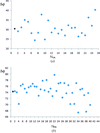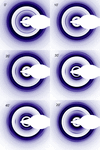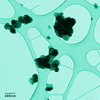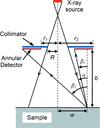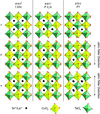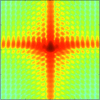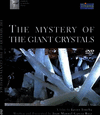issue contents
June 2011 issue

Cover illustration: Selected images of optical birefringence recorded during the heating of dodecasil-3C crystals. Courtesy of Lethbridge et al. [J. Appl. Cryst. (2010), 43, 168-175].
research papers
In the presence of phosphate anions, colloidal single-crystalline hematite particles grow as spindle-shaped particles whose aspect ratio can be tuned via the phosphate concentration. Because of the canted antiferromagnetism of hematite, the particles align with the long axis perpendicular to the external field, thereby inducing an isotropic–nematic phase transition in dilute suspensions.
A new strategy is described aiming at identifying the correct structure models among a large number of feasible trials generated by the application of direct methods to structure factor moduli estimated by a powder pattern systematic decomposition procedure.
A complete texture analysis of an Al thin film and of α-MnS nanocrystals deposited on a carbon film grid has been carried out using the Rietveld procedure embedded in the software MAUD working on a set of powder electron diffraction patterns taken in different orientations.
The observed evolution of ferroelectric domains in Rb-doped potassium titanyl phosphate (KTP) as the Curie temperature is approached is explained by competition between a built-in electric field and the coercive field.
Analytical considerations are compared with numerical simulations regarding the optimum velocity of a moving mosaic crystal used to achieve a phase-space transformation.
The structure of poly(ethylene propylene)-b-poly(ethylene oxide) (PEP–PEO) block copolymer micelles is determined by combining static light and small-angle X-ray scattering. These two techniques employ different contrasts and provide information on, respectively, large and short length scales.
This paper describes how two modern computational techniques can be used together to optimize an entire neutron guide system, in this example the H5 guide system at the Institut Laue–Langevin.
Sources of thermal slip have been identified at the extremity and bevel edge of large-diameter silicon wafers. The short duration of rapid thermal annealing prevents the propagation of these dislocations in the body of the wafer, rather than suppressing nucleation.
This combined study using small-angle neutron scattering, X-ray powder diffraction, transmission electron microscopy and adsorption isotherm techniques demonstrates radical changes in the microstructure of porous hematite nanoparticles upon calcination in air.
The inhomogeneity of proton polarization induced by dynamic nuclear polarization in a lamella-forming diblock copolymer film has been precisely evaluated by small-angle neutron scattering.
A novel X-ray diffraction technique with remarkable insensitivity to the sample morphology is described for the first time. The technique is based on energy-dispersive X-ray diffraction in a back-reflection geometry.
Utilizing freely available image processing software combined with medical tomography algorithms the three-dimensional structure of dislocation loops in silicon can be examined. The rendered images can be rotated to examine the loops from any desired projection.
A method is presented for the correction of crystalline, amorphous powder and nanoparticle neutron total scattering data with large amounts of nuclear incoherent scattering from hydrogen. The effects of correction on experimental atomic pair distribution function data sets are evaluated and the value of such corrections for several samples is demonstrated.
It is shown that textures with double-axis averaging similar to the a-texture, or Keller–Machin Type I texture, are not specific to semicrystalline polymers exhibiting twisted lamellar growth; the same texture is observed in extruded fibers of a typical discotic molecule, trans-diC60-Zn porphyrin. The characteristic `comma'-like azimuthal intensity profiles of the non-equatorial diffraction peaks in two-dimensional X-ray patterns are described using a simple analytical model, which shows good agreement with experiment.
The first systematic theoretical study regarding the small-angle scattering properties of the Platonic solids, including the tetrahedron, hexahedron, octahedron, dodecahedron and icosahedron, is presented, and the general characteristics of the single-particle spatial correlation functions corresponding to the Platonic systems with different sphericities are discussed.
The small-angle neutron scattering spectrometer SANS-U has been successfully upgraded from a conventional pinhole small-angle neutron scattering spectrometer to a focusing small-angle neutron scattering spectrometer.
The entrance to the Zaouïa Moulay Idriss II in Fez, Morocco, contains the only known example of a dodecagonal quasiperiodic cartwheel pattern in Islamic art. Its geometry satisfies the dodecagonal Ammann quasilattice and is close to the geometry of a diffraction pattern from a dodecagonal quasicrystal.
X-ray diffraction and associated analysis methods are described for examining the real-time microstructure of shock-compressed single crystals. The methods are demonstrated for an Al(100) crystal shock compressed to 7.1 GPa.
The order–disorder contributions to the ferroelectric properties of Cd2Nb2O7 have been studied by Monte Carlo simulation of a 12-state modified Potts model on the pyrochlore lattice.
Download citation


Download citation


The crystal structures are reported for SrLaCuNbO6 and SrLaCuTaO6, refined from neutron and synchrotron X-ray powder diffraction data at variable temperatures. Profile analysis and electron diffraction indicate significant local-scale behavior in these materials.
The relaxor ferroelectric PbMg1/3Ta2/3O3 was studied by single-crystal neutron and synchrotron X-ray diffraction, and its detailed atomic structure modelled in terms of static Pb displacements that lead to the formation of polar nanoregions.
The development of a uniaxial tensile loading stage with optical tracking capabilities for X-ray microdiffraction experimentation is detailed. Stage testing was carried out using a polycrystalline commercial-purity Ti sample. Synchrotron X-ray microdiffraction results indicated that the elastic–plastic response of individual grains could be measured with submicrometre spatial resolution.
teaching and education
Free 

The differences and distinguishing characteristics of incoherent scattering vis-à-vis diffuse coherent scattering due to atomic disorder are delineated and demonstrated experimentally.
short communications
It is shown that atom species of a crystal can be quantitatively retrieved from X-ray diffraction data.
CIF applications
Free 

A toolkit for conversion of CIF documents into complete semantic XML documents is presented.
computer programs
Scattering calculations from atomistic models using graphical processing units are presented and compared with the speed achieved using normal central processing unit calculations. An open-source software toolbox (PyNX) is presented, with a few examples showing the fast calculation of scattering maps from strained nanostructures, including grazing-incidence conditions.
The software StressTextureCalculator (STeCa) was designed to facilitate fast, easy and automated access to area-detector data. Its outstanding features are direct calculation of diffraction patterns from different types of area-detector measurements, automatic data treatment and peak fitting using several implemented fit options.
A computing resource (a web server and a database), Repeats in Protein Sequences (RPS), has been created. Using RPS, users can obtain useful information regarding identical, similar and distant repeats in protein sequences, check the frequency of occurrence of the repeats in several sequence databases, and view the three-dimensional structure of the repeats using the Java visualization plug-in Jmol.
The Basic Local Alignment Search Tool (BLAST) is one of the most widely used sequence alignment programs, but none of the existing tools for processing BLAST output provide three-dimensional structure visualization. This shortcoming has been addressed in the proposed tool BLAST Server for Structural Biologists (BSSB), which maps a BLAST output onto the three-dimensional structure of the subject protein.
laboratory notes
Download citation


Download citation


The upgraded single-crystal neutron diffractometer at the High Flux Isotope Reactor, Oak Ridge National Laboratory, is well suited for nuclear and magnetic structural studies. Both high-intensity and high-resolution modes are possible by changing the horizontal bending of the monochromator.
book reviews
Free 



 journal menu
journal menu









